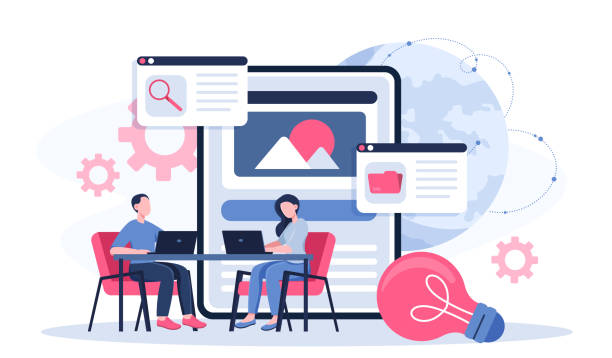1. Why is Multilingual Website Design Essential?

In today’s interconnected world, #limiting your business to a single language can mean ignoring a vast portion of the #global_market.
The fundamental question arises: why should we consider multilingual website design? The answer is simple: globalization.
Internet users worldwide speak various languages and come from diverse cultures, and when a website is presented in their native language, they will feel more comfortable and trusting.
This approach not only improves the #user_experience but also opens new doors for your business growth.
A single-language website, no matter how high-quality its content, will not be understandable to non-English or non-Persian speaking audiences.
This leads to losing countless opportunities to attract international customers.
From an #educational perspective, it is necessary to know how we can convey our message to a larger number of people by utilizing the potential of multilingual websites.
This is a strategic investment for a brighter future in the digital world.
Multilingual website design is no longer a luxury option; it is a competitive necessity.
Companies that adopt this approach demonstrate that they value the diverse needs of their customers and are ready to operate beyond geographical and linguistic boundaries.
This is an important step towards expanding the brand and increasing influence in new markets.
Do you dream of a thriving online store but don’t know where to start?
Rasaweb is your comprehensive e-commerce website design solution.
✅ Attractive and user-friendly design
✅ Increased sales and revenue⚡ Get Free Consultation
2. Amazing Benefits of Multilingual Website Design for Your Business

Multilingual website design brings significant benefits to any business aiming to expand its operations.
One of the most important advantages is access to global markets.
By providing content in multiple languages, you can reach customers in various countries who would otherwise never discover your website.
This leads to increased website traffic and, ultimately, a higher conversion rate.
Another point is improved SEO and search engine rankings.
Search engines index multilingual websites for different keywords in various languages, which means greater visibility in international search results.
Analytically, this allows you to collect more precise data about your global audience and optimize your marketing strategies.
Furthermore, strengthening brand credibility and professionalism is another direct result of multilingual website design.
A website accessible in multiple languages demonstrates a business’s commitment and seriousness in serving the global community.
This can serve as a powerful tool for building trust and loyalty among customers.
From an explanatory perspective, this capability allows you to tailor your message with the cultural nuances of each region, leading to a deeper connection with the audience.
Increased sales and revenue are the logical outcome of all these benefits.
By accessing a larger market and creating a better user experience, more customers are attracted and this directly impacts your bottom line.
Finally, greater market competitiveness distinguishes your website from competitors who operate in only one language and gives you a significant advantage.
3. Key Challenges and Solutions in Multilingual Website Design

Despite numerous benefits, multilingual website design is not without challenges.
One of the biggest obstacles is accurate content and translation management.
Translation is not merely replacing words; it must also consider cultural aspects, idioms, and even the tone of the content.
Machine translations are often inaccurate and can harm your brand.
The solution is to use native and expert translators who are fully familiar with the culture and linguistic nuances.
Additionally, choosing an appropriate Content Management System (CMS) that robustly supports multilingual functionality is crucial.
Another challenge is implementing multilingual SEO.
Correct URL structuring, using hreflang tags, and localized content for keywords in each language are complexities in this area.
Ignoring these can lead to lower search engine rankings.
From an analytical perspective, there is a need for continuous monitoring of each language version’s website performance to identify and resolve issues.
Another technical challenge includes choosing between subdomains, subdirectories, or top-level domains for each language, each having its own advantages and disadvantages.
To aid better understanding, a comparative table is provided which can be guiding in decision-making.
This thought-provoking content helps you understand the challenges and plan for them before starting the project.
| URL Structure | Example | Advantages | Disadvantages |
|---|---|---|---|
| Country Code Top-Level Domains (ccTLDs) | example.fr |
Strongest geo-targeting signal for SEO, higher user trust | More expensive, requires managing multiple domains, SSL certificate issues |
| Subdirectories | example.com/fr/ |
Ease of management, strong SEO signaling, more affordable | Potential for internal competition between language versions, less geographically specific |
| Subdomains | fr.example.com |
Easier management than ccTLDs, content separation, scalability | Weaker SEO than subdirectories, sometimes requires specific server configurations |
| URL Parameters | example.com?lang=fr |
Simplest implementation | Weakest option for SEO, crawling and indexing issues |
4. Choosing a Platform and Content Management System for Multilingual Websites

Choosing the right platform and Content Management System (CMS) is one of the key decisions in the multilingual website design process.
A powerful CMS should have native capabilities for managing multiple languages or provide this functionality through plugins and modules.
From a specialized perspective, some content management systems like WordPress with plugins like WPML or Polylang, Joomla with built-in multilingual features, and Drupal which natively supports multilingualism, are popular choices.
These platforms allow you to manage the content of each language separately, which is a major advantage for maintaining consistency and translation quality.
In addition to general CMSs, e-commerce platforms such as Shopify and Magento also offer solutions for building multilingual online stores.
When choosing, factors such as ease of use, scalability, multilingual SEO support, and the user community should be considered.
A good system should allow you to easily switch between languages, update translations, and even independently edit specific content for each language.
These capabilities ensure that the process of building a multilingual website is as smooth and efficient as possible.
For an explanatory and guiding content, it is recommended to review different demos and consult with expert developers before making a final decision to choose the best option tailored to your specific business needs.
Do you dream of a thriving online store but don’t know where to start?
Rasaweb is your comprehensive e-commerce website design solution.
✅ Attractive and user-friendly design
✅ Increased sales and revenue⚡ Get Free Consultation
5. How Does Multilingual SEO Help Your Website Get Seen?

Multilingual SEO is one of the most complex yet crucial aspects of multilingual website design.
Simply having translated content is not enough; your website must be optimized for search engines in each language to reach its target audience.
From a specialized perspective, this process involves several key steps.
First, localized keyword research for each language is very important.
Words popular in one language may not be used or may have a different meaning in another language.
Therefore, using keyword research tools for each target language is essential.
Second, implementing Hreflang tags.
These tags inform search engines like Google which version of the page is suitable for which language and geographical region.
This prevents the problem of “duplicate content” and helps search engines show the correct version to users.
Third, appropriate URL structure (as discussed in chapter 3) plays an important role in multilingual SEO.
Using subdirectories or ccTLDs helps search engines understand the geographical target of your website.
From an analytical perspective, regular monitoring of SEO performance in each language and country, through tools like Google Search Console, is essential to identify and fix issues.
This news-oriented and up-to-date approach ensures that your multilingual website is optimized not only for users but also for complex search engine algorithms, leading to greater visibility and attracting organic traffic.
6. Effective Strategies for Multilingual Content Translation and Management

Content management in a multilingual website design goes beyond mere translation; it requires a strategic approach to ensure the quality, accuracy, and cultural relevance of content across all languages.
One of the most important recommendations is utilizing native and expert translators.
Machine translation can be useful for general understanding, but it is never sufficient for professional and specialized content that is meant to reflect your brand.
Human translators can consider cultural nuances, local idioms, and even jokes, which makes the content feel natural and trustworthy to the native audience.
Furthermore, creating a Glossary and Style Guide for translators is a smart move.
These documents ensure that key terms, product names, and your brand’s tone remain consistent across all languages.
This is an educational approach that helps translators align with your brand.
For thought-provoking content, one can go beyond localization and create content specifically written for each target market from scratch.
This means a deep understanding of the needs and preferences of audiences in each region.
Using Translation Management Systems (TMS) can also automate the process and increase efficiency.
These systems help manage translation projects, track progress, and maintain Translation Memory (TM), which saves costs and time in the long run.
Finally, regular content updates and reviews in all languages are essential to ensure its accuracy and timeliness.
7. The Role of User Experience (UX) in Multilingual Website Success

User experience (UX) plays a pivotal role in multilingual website design.
A successful multilingual website must not only provide content in multiple languages but also ensure that users from every language and culture have a smooth and pleasant experience.
One of the most important aspects is providing a clear and easy mechanism for language switching.
This option is usually located in the website’s header or footer and should be clearly visible.
Country flags, language codes (e.g., EN, FR, DE), or full language names are common methods for displaying this option.
Additionally, responsive design and compatibility with various devices are even more important for multilingual websites.
Users from different parts of the world may use diverse devices to access your website.
Ensuring fast page loading, especially for users in areas with slower internet speeds, is crucial.
This is an important aspect of guidance and improving user experience.
Understanding cultural differences in UI design is also very important; for example, text direction (right-to-left or left-to-right), colors, and symbols may have different meanings in various cultures.
To provide entertaining yet useful content, these subtle points must be considered.
For example, the “Contact Us” button should be correctly translated and placed appropriately in each language.
The table below summarizes key UX tips for multilingual websites.
| UX Factor | Description | Importance |
|---|---|---|
| Clear Language Switcher | Easy and distinguishable switching between languages | Avoids user confusion, increases accessibility |
| Text Direction (RTL/LTR) | Correct support for right-to-left (e.g., Persian) and left-to-right languages | Maintains readability and aesthetics for native users |
| UI Localization | Adaptation of dates, times, currencies, and local formats | Increases user comfort and trust |
| Images and Videos | Use of visually appropriate content for different cultures or adding subtitles/dubbing | More effective and inclusive communication with a global audience |
| Loading Speed | Optimizing loading speed for all language versions | Reduces Bounce Rate and improves SEO ranking |
8. Testing and Maintenance of Multilingual Websites

After completing multilingual website design and implementation, the process of continuous testing and maintenance is of paramount importance.
A multilingual website requires constant care and monitoring to ensure that all language versions function correctly and provide a consistent user experience.
Comprehensive testing should include checking the accuracy of translations, link functionality, correct display of fonts and images, and compatibility with different browsers in each language.
Also, it must be ensured that language switching works correctly and the user is redirected to the relevant page in the selected language.
This is an educational and guiding approach that helps your team identify and resolve potential issues before serious problems arise.
Regular maintenance involves content updates, fixing technical errors, and improving overall website performance.
As the main website content is updated, it must be ensured that corresponding translations are also updated quickly.
This process can be facilitated using translation management systems.
From an analytical perspective, monitoring traffic, conversion rates, and user behavior in each language version provides valuable information for future optimizations.
Also, monitoring multilingual SEO (keyword rankings, indexing status, Hreflang errors) is essential to ensure the website’s visibility in search engines in different target markets.
A proactive approach to testing and maintenance helps maintain the health and efficiency of your multilingual website and prevents potential issues that could harm brand reputation.
This is a key element in the long-term success of building a multilingual website.
Did you know that poor online store design can drive away up to 70% of your potential customers? Rasaweb transforms your sales with professional and user-friendly e-commerce website design.
✅ Significant increase in sales and revenue
✅ Full optimization for search engines and mobile devices
⚡ [Get Free Consultation from Rasaweb]
9. Key Tools and Resources in Multilingual Website Design

To facilitate the multilingual website design process and its management, there are a set of tools and resources that can be of great help.
From a specialized perspective, Translation Management Systems (TMS) such as Trados Studio, MemoQ, and Smartling, organize and automate the translation and localization process.
These tools offer features like Translation Memory (TM), glossaries, and management of large translation projects, which help maintain consistency and reduce costs in the long run.
This is explanatory content for those seeking advanced solutions.
In addition to TMS, multilingual SEO tools such as Google Search Console and Ahrefs (for keyword and backlink analysis in different languages), and Screaming Frog (for checking Hreflang errors) are of high importance.
These tools help you monitor your website’s SEO performance in each language and identify and fix issues.
For the educational aspect, online resources such as specialized SEO blogs, web developer forums, and localization training courses provide you with the necessary knowledge.
Also, hiring a multilingual expert team including native translators, international SEO specialists, and web developers experienced in multilingual website design, can be a very effective investment.
These tools and resources simplify the complex process of designing and maintaining a multilingual website, allowing you to enter and compete in global markets with greater confidence.
10. The Future of Multilingual Website Design and New Trends

The future of multilingual website design is full of new trends moving towards artificial intelligence (AI) and deeper localization.
From a news perspective, recent advancements in Neural Machine Translation (NMT) and Natural Language Processing (NLP) mean that automated translation tools are becoming more accurate and capable.
While these technologies cannot yet fully replace human translators, they can speed up the initial translation process and reduce costs, especially for large volumes of content or quick updates.
This is an analytical content that addresses the future outlook.
Localization beyond translation is another important trend.
This means fully adapting the content to the cultural norms, interests, and even lifestyles of the native audience.
This includes images, videos, colors, and even brand storytelling.
Entertaining and engaging content that resonates with the local culture can significantly increase customer loyalty.
From an educational perspective, website design platforms in the future will likely offer multilingual and localization capabilities natively, without the need for complex plugins, which will make the multilingual website design process easier for small and medium-sized businesses.
The increasing importance of multilingual voice search and the need to optimize content for this type of search is also an emerging trend.
Given these changes, multilingual website design will move towards deeper personalization and fully localized user experiences, which will provide countless opportunities for more effective communication with global audiences.
Frequently Asked Questions
| Number | Question | Answer |
|---|---|---|
| 1 | What is multilingual website design? | Multilingual website design means building a website whose content is available to users in several different languages. This is usually done through a simple user interface for language switching. |
| 2 | Why should we design a multilingual website? | Designing a multilingual website helps you reach more audiences worldwide, provide a better user experience for international users, and improve your global SEO. |
| 3 | What are the main methods for implementing multilingualism on a website? | The main methods include using subdomains, subdirectories, or URL parameters for each language, as well as using completely separate domains for each language. |
| 4 | For SEO, is it better to use subdirectories or subdomains? | In terms of SEO, both subdirectory and subdomain methods can be effective. However, many SEO experts prefer subdirectories due to better transfer of the main domain’s authority. |
| 5 | What are the important tips for translating multilingual website content? | Translation should be done by native translators; content should be localized in addition to translation to align with the target audience’s culture; and avoid relying solely on machine translation. |
| 6 | What is the role of the hreflang tag in multilingual site SEO? | The hreflang tag helps search engines like Google display the correct language and regional version of a page to the appropriate users, which also prevents duplicate content issues. |
| 7 | Can a website be made multilingual without coding? | Yes, in Content Management Systems (CMS) like WordPress, powerful plugins such as WPML or Polylang exist that enable making a website multilingual without needing to code. |
| 8 | What are the challenges of multilingual website design? | Challenges include translation management, content localization, adherence to SEO principles for each language, technical support for different languages, and ensuring design consistency across different languages. |
| 9 | What is the difference between translation and localization? | Translation is simply converting words from one language to another, while localization involves adapting content to the culture, customs, currency, date and time formats, and even appropriate colors for the target audience. |
| 10 | What is the best user experience (UX) for a language switch? | A clear and accessible language switcher (usually in the header or footer), using the language name instead of flags (due to regional diversity), and maintaining the user’s position after changing the language are important UX tips. |
And other advertising services of RasaWeb Advertising Agency
Smart Customer Journey Map: Exclusive service for customer acquisition growth based on SEO-driven content strategy.
Smart Content Strategy: An innovative platform for improving customer behavior analysis with marketing automation.
Smart Direct Marketing: An effective tool for customer acquisition with attractive UI design.
Smart UI/UX: Designed for businesses looking to increase click-through rates through user experience customization.
Smart Google Ads: Professional optimization to boost sales using intelligent data analysis.
And over hundreds of other services in the field of internet advertising, advertising consultation, and organizational solutions
Internet Advertising | Advertising Strategy | Advertorials
References
The Importance of Multilingual Website Design in Global MarketsKey Tips for Designing International WebsitesMultilingual Website SEO and Traffic IncreaseHow to Increase Your Sales with a Multilingual Website
?With Rasawweb Afarin, take your business to new heights in the digital world! We pave the way for your online success by providing comprehensive digital marketing agency services including responsive website design, SEO, and content creation.
📍 Tehran, Mirdamad Street, next to Bank Markazi, Kazeroun Jonoubi Alley, Ramin Alley, No. 6



